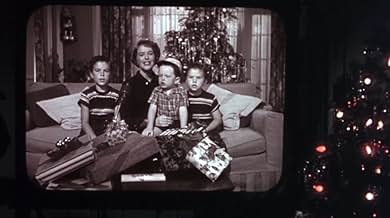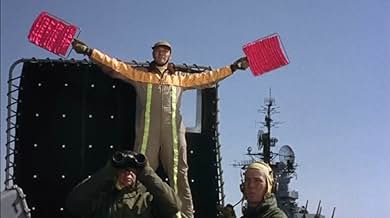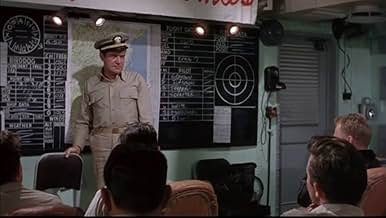Un escritor que sirve en un portaaviones estadounidense durante la guerra de Corea observa las historias de los hombres que le rodean cuando acuden a una misión.Un escritor que sirve en un portaaviones estadounidense durante la guerra de Corea observa las historias de los hombres que le rodean cuando acuden a una misión.Un escritor que sirve en un portaaviones estadounidense durante la guerra de Corea observa las historias de los hombres que le rodean cuando acuden a una misión.
- Dirección
- Guionistas
- Elenco
- Mary, Schechter's Fiancee
- (sin créditos)
- Officer
- (sin créditos)
- Home Movie Commentator
- (sin créditos)
- Andy Szymanski Jr.
- (sin créditos)
- Replacement
- (sin créditos)
- Richard Dodson
- (sin créditos)
- Soldier
- (sin créditos)
- Dirección
- Guionistas
- Todo el elenco y el equipo
- Producción, taquilla y más en IMDbPro
Opiniones destacadas
A Korean war drama movie with flag-waging American sentiment , thrills , emotion , dangerous aerial scenes , occasional drama , battle scenes and a lot of stock footage . Features the stories of selected pilots stationed on a US aircraft carrier in the Pacific during the Korean war . The stories told to Louis Calhern as writer James A Michener , centering around pilot Van Johnson and standing out his feat in which he helps a blinded Dewey Martin land his aircraft safely on the carrier deck . This is a powerful film competently directed by Andrew Marton and it displays extremely realistic aerial sequences , in fact this picture was made with the cooperation of the department of Defense and the United States Navy , with particular appreciation to Commander Air Force , US Pacific fleet and the officers and men of his command . This exciting and thrilling film focus on the group of pilots and their perilous missions on their planes . Gene Ruggerio's editing of the war footage was so expertly made that he was even questioned by the Pentagon when they had a hard time believing the scenes were achieved by skillful mountage and painted backdrops . This Metro-Goldwyn-Mayer (MGM) (1954) production is a hell of a war movie , combining with some effective quiter moments . It is plenty of riveting technical detail and there's richly rounded support cast . There's also also an introspective real guy interfacing by the ensemble cast , as well as a nice group of actors giving fiercely well-defined portrayals of pilots and soldiers under stress , being masterfully played by a lot of familiar faces , such as : Van Johnson , Walter Pidgeon, Louis Calhern , Keenan Wynn , Frank Lovejoy, Robert Horton , Bert Freed , among others, and look for 'Beaver' Jerry Mathers as one of Keenan Wynn's sons.
It displays a moving and rousing musical score by classic composer Miklós Rózsa . It's all topped off with the vividly charming cinematography which typified the Korean war period from director of photography George Folsey . This propaganda and agreeable picture was professionally directed by Andrew Marton , and there this great filmmaker creates some nice aerial action scenes , as it has worn well through the years , in spite of the extremely jingoist and patriotist yarn . Marton's filmmaking is masterly in its economy , power and pace . Craftsman director Marton made a lot of films in all kind of genres and creating good works . Marton was a specialist on Wartime movies, such as : ¨The thin red line¨also based on James A. Michener movie , ¨The longest day ¨and adventure movies as ¨African Texas style¨, ¨Around the world under the sea¨, ¨Clarence , the cross-eyed lion¨, and ¨King Salomon's mines¨(1950) co-directed by Compton Bennett and Andrew Marton directed the second unit , he then was tasked with replacing Compton Bennett as director after the latter had been taken ill . One of his more prestigious assignments came about by chance to lay in some excellent work as second-unit director , notably in charge of the chariot race for William Wyler's ¨Ben-Hur¨ (1959), as well as of the Normandy invasion sequences for the World War II in the sensational ¨The Longest day¨(1942) . After his contract with MGM expired in 1954, Marton founded his own production company in conjunction with fellow Hungarian émigrés Ivan Tors and Laslo Benedek . He later concentrated on TV adventure series, helming the pilots, respectively for "Daktari" (1966) and "Cowboy in Africa" . Men of the Fighting Lady (1954) rating : 6.5/10 , better than average.
The lives of jet fighter pilots aboard the Fighting Lady in the Sea of Japan and their treacherous missions to destroy key North Korean military installations serve as the exposition for this slice-of-life, often neglected chapter in American war history. The mood and atmosphere of the film contain an unmistakable Korean War grimness that clouds over the men from beginning to end as they cut through the harsh North Korean skies battling ceaseless anti-aircraft fire in mission after mission.
MEN OF THE FIGHTING LADY is unromantic and raw. It's theme is the harsh, day-to-day experience of jet pilots who flew their missions under the gloom of being shot out of the air. For it is well worth remembering that unlike Viet Nam and subsequent Iraq wars, Korean War bombing missions exposed pilots to blistering anti-aircraft fire and attacking enemy aircraft resulting in numerous pilot casualties and downed planes. Not to be forgotten is that the Korean War was the first, full-blown "jet aircraft war" in history.
The opening of the film begins with a nostalgic flashback over "ham and eggs" recalled by Louie Calhern who recalls the episodes aboard the Fighting Lady and the lives of heroic pilots during the Korean War conflict. The lives of the men and their interaction with their commanders lead to the film's signal sequence in which Ensign Kenneth Schecter (Dewey Martin) is strafed by enemy fire in his cockpit while on a mission and radios back that he is blind. Lt Thayer (Van Johnson) calms him and ultimately talks him back to a perfect landing aboard the Fighting Lady. In another moving scene at Christmas, the entire squadron watches movie footage of a pilot's wife sending her love to her husband---who had just lost his life on a mission.
Frank Lovejoy and Walter Pigeon are perfect fits as salty naval officers bearing up under the harsh war conditions in the Sea of Japan at that time. Former MGM musical comedy star Van Johnson is excellent as Lt. Thayer guiding the sightless ensign back in safely to the carrier deck. A young Kennan Wynn portrays the anxiety of a flight deck signalman very effectively.
There may have been better Korean War films--BRIDGES AT TOKO-RI, PORK CHOP HILL, RETREAT, HELL, but many of those fine films are packaged within romantic portrayals of war. MEN OF THE FIGHTING LADY has no romantic sub-plot, no love story, and, in short, no women. The film is superior in its depiction of the reality of a jet pilot's life walking the thin line between returning from a mission in one piece and facing annihilation. MEN OF THE FIGHTING LADY also contains effective and very real stock footage of jet take-offs and landings as well as North Korean targets under actual cannon fire from American sorties.
MEN OF THE FIGHTING LADY should be viewed by anyone interested in the true mood and atmosphere of the Korean War years when a jet pilot faced demise on every mission--and for the time in our nation's history when Starfighters and Scorpian jets ruled the skies over the Sea of Japan.
Trivia: MEN OF THE FIGHTING LADY should not be confused with the 1944 release THE FIGHTING LADY starring Charles Boyer and Robert Taylor. That film follows the exploits of the USS Yorktown.
Dennis Caracciolo
Released a year after the war, this is adapted from a magazine story by Michener. The use of the real thing and some real footage helps heighten the intensity. Seeing the real thing is fascinating even all these years later. Seeing the real bombing runs must have been compelling back in the day. I do remember the plane explosive crash on the carrier deck from somewhere else. I wonder if this is where it came from. Otherwise, the story is simple and the characters don't really stand out. These are good character actors and they do a solid job. As for the climatic story, it's just not that dramatic. The drama is concentrated on the landing and it's not that in doubt.
¿Sabías que…?
- TriviaF9F Panther jets from US Navy squadron VF-192 were also used to film The Bridges at Toko-Ri (1954). After the filming of these two movies, the squadron name was changed from "Golden Dragons" to "World Famous Golden Dragons".
- ErroresDuring the emergency landing sequence, when the plane is shown landing and being stopped by the barrier, the nose gear collapses and the nose cone crumples. In the next shot, the plane is still in the barrier, but the nose gear is extended and the nose cone is not crumpled.
- Citas
Comdr. Kent Dowling: [Greeting visiting author James Michener] You know, until I read your book "Tales of the South Pacific", I didn't know what a wonderful time I had in World War Two.
James A. Michener: Neither did I until Rodgers and Hammerstein set it to music.
Comdr. Kent Dowling: Why didn't you stop while you were ahead? Even Shakespeare couldn't make this dirty little war romantic.
- ConexionesFeatured in La batalla de Midway (1976)
Selecciones populares
Detalles
Taquilla
- Presupuesto
- USD 829,000 (estimado)
- Tiempo de ejecución
- 1h 19min(79 min)
- Relación de aspecto
- 1.75 : 1


































